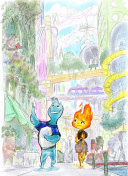


The World Cup is one of the most anticipated sporting events, captivating millions of fans around the globe. While traditional sports broadcasts have been popular, the introduction of cartoonist-inspired coverage has added a unique and entertaining twist to this prestigious tournament. This article aims to explore the world of cartoon broadcasts and discuss their impact on the World Cup.
Cartoon broadcasts have gained popularity in recent years, offering a refreshing alternative to traditional sports commentary. These broadcasts use animated characters and exaggeration to bring an extra element of fun and entertainment to the viewers. The idea originated from the desire to engage viewers of all ages, not just dedicated sports enthusiasts. The colorful and lively animated graphics, coupled with witty humor, create an immersive experience that captivates both children and adults.
Cartoon broadcasts not only entertain but also enhance the overall viewing experience for World Cup fans. The use of cartoons allows broadcasters to showcase replays and analysis in a visually appealing manner. Drawing attention to key moments and delivering insightful commentary through animated characters makes the information more accessible and memorable. Additionally, the spontaneous nature of cartoons enables broadcasters to inject humor into the match commentary, fostering a jovial atmosphere among viewers.
One of the notable advantages of cartoon broadcasts is their global appeal. With the absence of language barriers, these broadcasts have the power to reach audiences worldwide. Countries with diverse demographics and different levels of football knowledge can all enjoy this unique coverage. Moreover, this style of broadcasting can appeal to children who may otherwise find traditional sports commentary challenging to understand. By engaging a wider audience, cartoon broadcasts contribute to the growth and popularity of the World Cup as a global sporting event.
Despite their popularity, cartoon broadcasts have faced criticism from purists who argue that they undermine the seriousness and authenticity of the World Cup. Some enthusiasts believe that the exaggerated animations and humorous commentary deviate from the true essence of the game. However, it is important to remember that cartoon broadcasts are not meant to replace traditional coverage but rather to provide an alternative experience. In the future, there is potential for further technological advancements, such as augmented or virtual reality, that could further revolutionize the way we watch and enjoy the World Cup.
In conclusion, the introduction of cartoon broadcasts has added a delightful and engaging twist to the World Cup viewing experience. These broadcasts have not only enhanced the overall entertainment value but have also broadened the tournament's global appeal. While some may criticize their departure from traditional coverage, it is clear that cartoon broadcasts have secured their place as a beloved and unique part of the World Cup.
